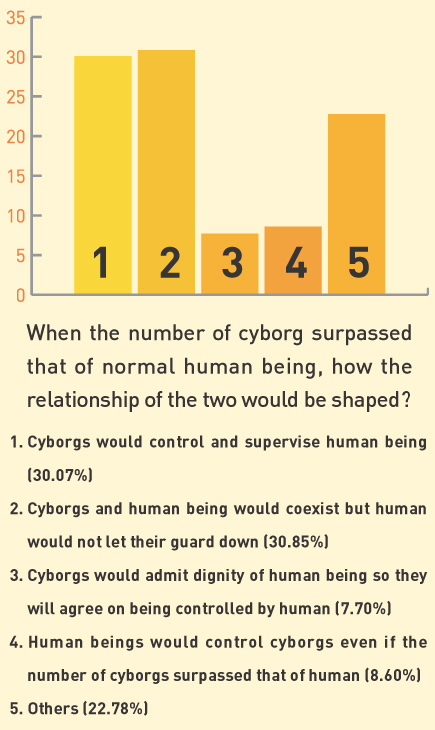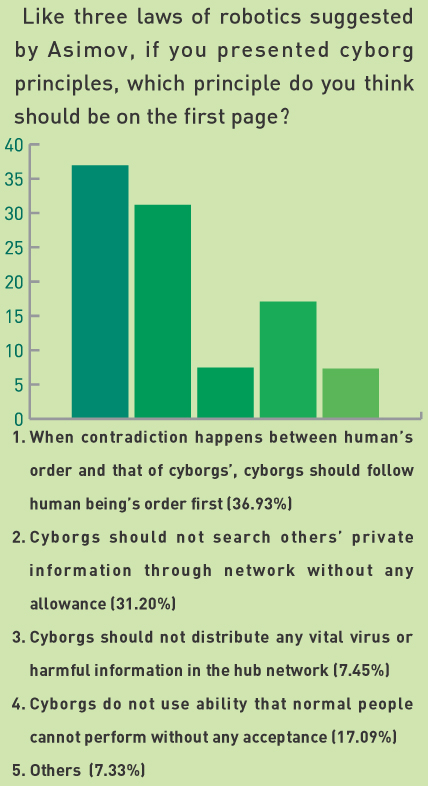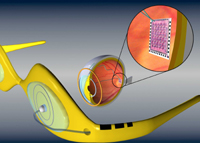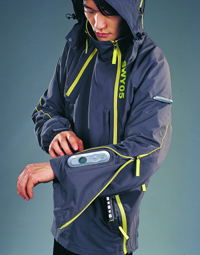Machines are replacing our body
Right now, I’m sitting in front of my notebook computer typing my articles. With each stroke of the keyboard, my thoughts are clearly expressed. The computer has become so convenient now; I no longer have to write with a pen. Then, suddenly a thought occurred to me. What would I do if the computer had a mind of its own and started typing its own ideas? My article would no longer be mine. Technology has become a dominant part of our lives and we don’t even realize it. Although we have some reservations about technology, we still depend so much on it. Therefore, The Yonsei Annals decided to find out where scientific technology is heading, by interviewing five experts in different fields and surveying 1,190 Yonseians’ thoughts about CYBORGs.
SURVEY 1

SURVEY2

SURVEY 3

Laws of robotics by Issac Asimov
1. A robot may not injure a human being, or through inaction, allow human being to come to harm.
2. A robot must obey orders given it by human being except where such orders would conflict with the First Law.
3. A robot must protect its existence as long as such protection does not conflict with the First and Second Law.
SURVEY4

SURVEY5

Kevin Warwick, a professor of cybernetics and a scientist, conducted an experiment by inserting chips to his own arm and his wife’s in 2002. This experiment was done to see if two participants could share their feelings through computer chips and it was successful! Seeing him, we can cautiously expect the day when we will be able to use telepathy to talk. However, before imagining the fabulous day of a cyborgnetic world, we should think about what we need to prepare ourselves. The two most popular responses for the question, “To keep in pace with growing technology of cyborg, what is the most required precaution that university students should take?,” are “Discussion on the matter of making cyborgnetic ethical and its regulations (29.56%)” and “Efforts to absorb developing technology as fast as possible (20.15%).” This means to develop cyborgnetic technology suitable for us, a basic concept of ethnics needs to be addressed as well as keeping up with technical developments.
“A fundamental rule in technology says that whatever can be done will be done,” said Andrew Grove, one of the founders of Intel corporation. However, it would have been better to say “whatever can be done will be done based on our decision,” to make sure that humans have rights to determine their lives. Some people assert that the history of humans will end as technology becomes superior, however, others refuse it. Whether to reject or accept the advent of cyborgs depends on individuals, but remember: face the reality, and make your decision. Your decision should be based on the reality, not your illusion or ignorance.
NANOBIOLOGY, Promising with so much potential

Nano is a prefix indicating -9 powers of 10. The United States’ National Nanotechnology Initiative website defines nanotechnology as “the understanding and control of matter at dimensions of roughly 1 to 100 nanometers, where unique phenomena enable novel applications.” When applying nanotechnology with biology or vice versa, it is called “nanobiology.”
“The ability to see things on a nano scale is a great advantage to biology. Using this method, it is possible to improve the effectiveness when inventing new drugs,” said Park Je-gyun, the chairman of Biosystem, KAIST (Korea Advanced Institute of Science and Technology). If nanotechnology is grafted together with biotechnology, it could contribute to disclosing the secret of cells and also help develop new drugs by studying sick cells. This is called “Nanomedicine.” For example, the process of curing cancer through DDS (Drug Delivery System) helps antibody bond with minute particles to which medicine is inserted. After surfing and flicking around cancer cells, the antibody releases medicine as a reaction to a situational change, like the temperature around cancer cells or a low PH index.
Even if the scale of nano is too small to see, the results it can bring to us will be overwhelming. The way nano technology form our future is worth waiting for.
OPHTHALMOLOGY, Eyes and Technology
Ophthalmology is the branch of medicine which deals with diseases and surgeries of the visual pathways, including the eye and brain (Wikipedia). To learn about artificial retina surgery and its future, Annals met with Koh Hyoung-jun, a doctor who specializing in treating retina diseases, cataract diseases and other ailments of the eye.
“The retina is a nerve tissue formed like a well-developed disk. We can classify the artificial retina surgery into three parts: cortical implant, optic nerve prosthesis, and retinal prosthesis. The surgery is still in the first stage of development,” said Koh.
 |
Most of the studies are concentrated in “retina prosthesis.” It also can be classified according to how the surgery is performed. One method, implanting an artificial retina on the upper part of the eye, lets the patient wear glasses in which a camera is placed. When the glasses see some image, it sends these to a microprocessor built in the camera. The images are converted to electric signals so that an electrode underneath the artificial retina can accept it. Finally, signals give an impetus to healthy nerve cells in order to enhance eyesight.
“Currently, a second animal experiment (60 electrodes) on artificial retina is on the way. The more electrodes we plant, the better the patient can see. However, it is hardly possible to cure all the retina diseases,” added Koh, warning us from thinking an artificial retina is the magical cure for every ailment.
BIOMATERIALS, Having much to expect
 | ||
| ▲ Koh Won-gun, the Assistant professor of chemical engineering, Yonsei Univ. |
In surgery, a “biomaterial” is a synthetic material used to replace part of a living system or to function in intimate contact with living tissue (Wikipedia). “There are natural and synthetic polymers in biomaterials. While natural polymers are hard to produce in large quantities, synthetic polymers are not,” said Koh Won-gun, the assistant professor of chemical engineering, Yonsei Univ.
Synthetic polymers include synthetic fabrics, plastics and so forth. However, even if synthetic polymers have the benefit of limitless quantity, it has to be approved by the FDA (Food and Drug Administration) and also needs to be appropriate when being used inside the body. “A biomaterial like PEG (Polyethylene Glycol) is not perceived as part of the body so it is not attacked by antibody. Therefore, materials which are perceived by antibodies are inserted after being coated by PEG in order not to be attacked by antibodies,” added Koh.
Biomaterial varies depending on which organ it is being used for. For example, biomaterial used for artificial bones should be superior in intensity and hardness, and materials for artificial tissues should be resistant to infections.
Biomaterial is not unfamiliar to students; we can easily see people with artificial arms or legs, and frequently meet people who have had plastic surgery. The era of biomaterial gives opportunity to people unable to attain their dream because of a physical handicap. Because the freedom and hope that biomaterial technology provides, people look forward to its great potential.
SMART CLOTHES, Coming soon
 | ||
| ▲ Cho Gil-soo, the leader of the team, "Smart clothes for future life" |
On May 2006, Apple and NIKE demonstrated “Nike+iPod Sport Kit,” a sport shoe with a censor attached to interact with iPod. The person who wears “Nike+iPod Sport Kit” can see how much he ran, how many calories he burned, and so on by looking at the iPod liquid crystal.
“Smart clothes,” indicating clothes on which digital function is applied is just around the corner to meet customers’ needs. “Since 2004, the ministry of commerce, industry, and energy supported a project team called “Smart clothes for future life.” The project team has a plan to put clothes with built-in MP3 players on the market on the latter half of this year. When placing MP3 technology inside clothes, we use a textile for signal transmission, not wire. So it is not dangerous at all,” said Cho Gil-soo, the leader of this team.
 | ||
| ▲ Smart clothes |
This five-year project costs about ₩150 billion, and the half of the research was financed by the government, the other half by enterprises, like Hyosung and Kolon.
“When the clothing industry, ‘the third most profitable industry in Korea,’ joins the domestic IT industry, which is recognized throughout the world, Korea will have a strong position in the field of smart clothes” said Cho positively.
CYBORG MOVIE, What it tells
“It is appallingly obvious that technology exceeds humanity,” said Albert Einstein. It seems even in the era of Einstein, the development of technology was perceived as a horror. People are overwhelmed by technology, but in the deepest part of their heart, they have fear. “In cyborg movies, it is described as the conflict between human and machines, and the next question is how to control and solve this conflict,” said Jang Sae-hee in her master’s dissertation “Research on cyborg movies: conflict between humanity and mechanical character(2001).“
 | ||
| ▲ The Movie, "Matrix" |
In “Terminator 2: judgment day,” the dystopia where machines became superior to men after a nuclear war is described. Additionally, the dystopia that is described in movies varies. “When people started to become interested in the economy after the Cold War, movies depicted dystopia where everything is decided by the logic of capitalism. Also, as depicted in “The Matrix,” fear of being ruled by machines is shown in the movies,” added Jang.
“The Matrix” and “The Terminator” had something in common in the end. Both depicted a man who physically had mechanical power, yet emotionally remained as a human. So to speak, the concept of “humanity” is described as the hope of humanity and the only alternative for the future. “The thing that symbolizes these concepts is ‘familism.’ In movies, communication between members of a family is suggested as the only hope for the unstable future,” she said.
QUESTION AND ANSWER
CYBORG A compound word of ‘Cybernetic’ and ‘Organism.’ It indicates an organism that reconstructs or improves their bodies by using technology.
FYBORG A compound word of ‘Functional’ and ‘Cyborg.’ It is a subordinate concept of cyborg. Fyborg uses technology like wearing glasses, doing computers which we can face everyday. Most of people today are ‘Fyborgs’
ROBOT Robot is an artificial, intellectual and mechanical agent. (Wikipedia) The significant difference between robots and cyborgs is that robots do not need to be linked to an organism.
ANDROID An android is a robot made to resemble a human, usually both in appearance and behavior. (Wikipedia)
DIFFICULT WORDS
RETINA The retina is a thin layer of neural cells that lines the back of the eyeball of vertebrates and some cephalopods. It is comparable to the film in a camera. (Wikipedia)
CORTICAL Relating to the cortex. Cortex is the outermost or superficial layer of an organ. (Wikipedia)
OPTIC Relating to the eye or vision, or relating to the science of optics or optical equipment. (www.thefreedictionary.com)
CEREBRUM The largest portion of the brain, divided into two hemispheres that each contains four lobes. Its functions include speech, memory, vision, personality and muscle control in certain parts of the body.
(www.cnn.com/HEALTH/library)
SPOTLIGHT
I especially give my thanks to all of the *Annals* staff, who had a hard time distributing surveys. Getting back survey results was the hardest thing to do, and students’ unwillingness to respond was the biggest cause of that. Students might feel awkward towards cyborgs, and I also did. However, cyborgnetic technology is not too far away. In fact, it has been with us, and it gradually has been developing. I hope you could feel the technical flow by reading my article.

